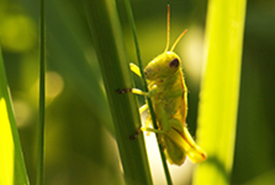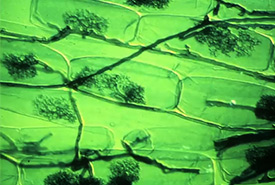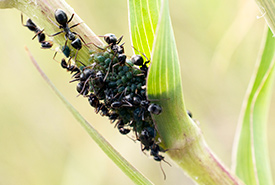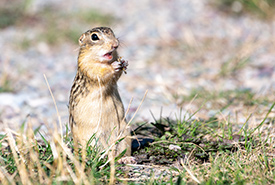The Web of Life in Grassland Soils

Grasshoppers impact the ecosystem above and below ground (Photo by Sean Feagan / NCC Staff)
Below the surface of our incredible Prairie grasslands lies a hidden world often overlooked. Prairie soils shape and are shaped by a complex web of life ranging in size from microscopic bacteria to animals as large as grizzly bears. Here are some major players in this complex game of life:
Bustling bacteria
The amount of bacteria in grassland soils is truly staggering. By some estimates, 10 grams of soil can contain one hundred billion bacteria comprised of 10,000 to 100,000 bacterial species!
There is still much to study about these soil bacteria, but one thing is sure: they are extremely important to grassland ecosystems. That’s because they perform critical functions such as nutrient cycling (the transfer and exchange of inorganic and organic matter), decomposition and nitrogen fixation (the conversion of free nitrogen in the air to reactive nitrogen compounds used by life).
Want to help our grasslands? Support the Prairie Grasslands Action Plan today!
Fantastic fungi
Fungi are another important and diverse group found within grassland soils. Some of these fungi are decomposers; they release enzymes that break down complex carbohydrates into more usable forms of sugars and nutrients.

Mycorrhizae hyphae entering a plant cell (Public domain image)
Other fungi form relationships with plants, known as mycorrhizae. In these normally mutually beneficial relationships, the fungi receive sugars made by the plants in exchange for providing nutrients, such as phosphorous and nitrogen. Mycorrhizae have also been shown to protect plants from pathogens.
Mycorrhizal associations may be particularly prevalent in the Prairies. For example, in one study conducted in the U.S., mycorrhizal associations were found in 96 per cent of 109 plant species spanning 25 families. Plants with high levels of mycorrhizae were the dominant grass species, and plants with large tap roots that might need a little extra help absorbing nutrients, such as goldenrod or thistle.
Important invertebrates
The soils of our prairie grasslands are home to diverse invertebrates. These arthropods perform many important functions, including soil aeration, pollination and organic matter decomposition.

Ants "farming" aphids on a blade of grass (Photo by Sean Feagan / NCC Staff)
Ants are common in grasslands and are known to transport and distribute seeds, improve soil structure through their tunneling activities, and contribute to nutrient cycling. Many prairie ants are attracted to plants that produce sugary nectar. In exchange for this tasty treat, they help guard the plant from insect predators! Others are known to farm aphids for the sugary waste the produce known as honeydew.
Another abundant and diverse insect group found in grasslands are grasshoppers. While grasshoppers spend much of their adult life above ground, they start life buried beneath the surface. Adult females use their egg-laying appendage, known as an ovipositor, to lay eggs up to 10 centimetres deep in the soil. These holes help water enter the ground, increasing the ability of grasslands to absorb and store water.
Enjoying this story? Sign up for our newsletter!
Gophers and ground squirrels
Burrowing animals, like prairie dogs, ground squirrels and pocket gophers, are pivotal in Prairie grassland ecosystems. They create intricate underground habitats that house a wide variety of species, from insects to amphibians and other mammals. Their digging activities enhance soil aeration, soil structure and nutrient cycling and, as a result, are considered ecosystem engineers.

Thirteen-lined ground squirrels are voracious predators of insects (Photo by Sean Feagan / NCC Staff)
These small mammals are the primary food source of many animal predators of the Prairies, including badgers, coyotes and hawks. For example, it is estimated that a single breeding pair of ferruginous hawk eats more than 500 ground squirrels or similar prey in a single breeding season!
Over a dozen small mammal species can be found in the Prairie grasslands. But perhaps the most striking is the thirteen-lined ground squirrel, which is named after its beautiful striped coat. While you might think of these small squirrels as herbivores, they are voracious predators of insects and sometimes even vertebrate prey, such as young birds.





